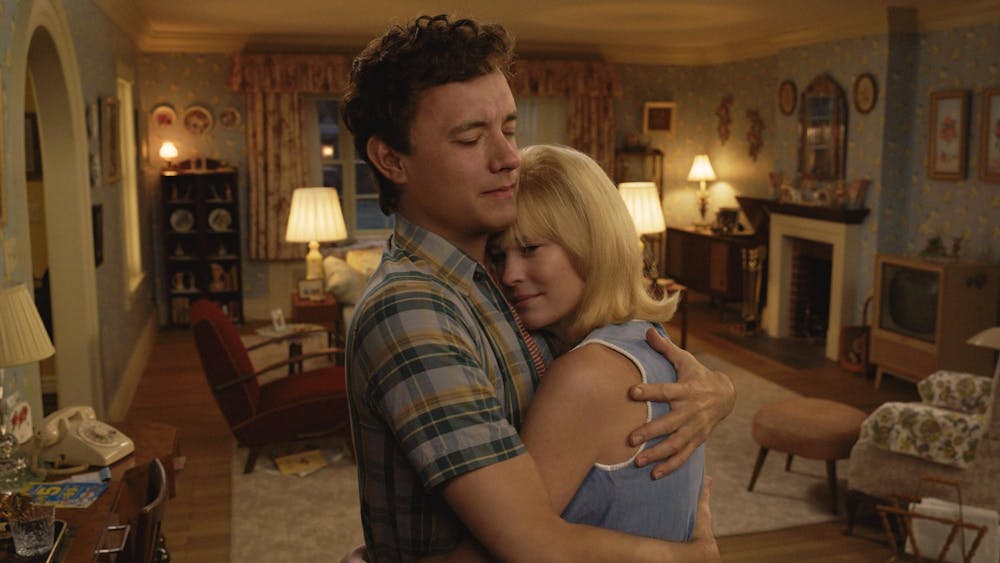“Here,” released in movie theaters Nov. 1, 2024, is a coming-of-age American drama. It is a generational story about families and the special place they inhabit, sharing in love, loss, laughter and life.
The film is directed by Robert Zemeckis, director of the “Back to The Future” series, “Forest Gump” and “Cast Away.” He is no stranger to blending cutting-edge technology with deep human emotions. With all his films, Zemeckis has always had a knack for merging high-concept ideas and portraying the connections that shape our lives.
“Here” tells the story of a single house, its history and the people who have lived inside or on its land. The film is told in a nonlinear fashion — the screen is often subdivided into multiple panes, presenting events from different time periods simultaneously. Digital de-aging is used on much of the cast to have them portray their characters throughout different time periods. The de-aging is jarring and noticeable because it is obvious that the actors remain the same, they just look a lot younger. The artificial intelligence tools are able to make Tom Hanks go from looking 68 years old, which he is today, to appearing 30 for several scenes.
It begins with dinosaurs roaming a vast landscape, followed by the onset of the Ice Age. As time progresses, Indigenous people settle on the land before the arrival of Benjamin Franklin’s family. All of the beginning scenes have AI-generated backgrounds. The narrative then shifts to the 20th century, where a home is built on this storied land, marking the next chapter in its long history. The story traces the lives of the original family who inhabited the home—Al (Paul Bettany) and Rose Young (Kelly Reilly) — whose lives become intertwined with the land and its past.
The film also follows Richard Young (Tom Hanks) and his wife, Margaret (Robin Wright), as they inherit the house from Richard’s parents. Spanning several decades, it explores their lives from age 18 into their 80s, capturing their evolving relationship and the challenges they face, including love and loss, personal growth and the impacts of a global pandemic.
The movie was projected to earn around $7 million at the box office but debuted at $5 million. Despite this, the film has resonated with audiences, with 74% of Google Users expressing a positive response. On IMDb, it holds a solid rating of 6.3/10, reflecting a generally favorable reaction. Although it has a rating of 36% on Rotten Tomatoes, some critics believe that the tech part of the film makes the plot less genuine.
What sets “Here” apart is its groundbreaking use of AI technology, which serves as more than just a plot device, marking one of Hollywood's first full-length features built around AI visual effects. By blurring the boundaries between human experience and artificial intelligence, the film dives into the relationship between the past and present in an era where memories can be digitally captured, replayed and even altered. The role of AI is central to the film, reflecting the complexities of our emotional connections to the past. According to Wired, the film crew could watch two screens simultaneously and see the actors de-aging in real time. The de-aging technology comes from time face-swapping, which is the ability to transform an actor’s face into a different age seamlessly. One screen showed the raw feed of the actors from the camera, and one side was filtered through AI tools, showing the actors at whatever age the scene required. According to The New York Times, the use of AI in “Here” is a critical element.
I think the use of AI in this film is really exciting because I have never seen anything like it. It is super interesting to know that filmmakers are incorporating AI into movies. I cannot wait to see what other movies do with AI. It has endless creative possibilities, and I think that AI is going to reshape the industry. Unlike previous aging effects used by filmmakers that relied on frame-by-frame manipulation, AI software Metaphysic generates age transformations instantly. AI enhances this film by using every available frame of Hanks’s and Wright’s movie careers to capture their facial movements and the look of their skin under different lighting conditions, physical environments and camera angles and lenses.
Movies are using artificial intelligence in innovative ways beyond just the aging and de-aging of actors. AI is transforming various aspects of filmmaking, from enhancing stunt choreography, like Digital Domain, a visual effects company that creates digital doubles, to improving the efficiency of foreign language and subtitles, like in the Polish movie “The Champion,” for which the filmmakers used AI to make an English version. AI also plays a big role in reshoots, allowing filmmakers to adjust quickly.
AI is reshaping how movies are made. During filmmaking, AI plays a crucial role in visual effects when directors want to include face-swapping instead of hiring look-alike actors and scenes that are impossible to recreate in real life. AI’s potential in the film industry is boundless; like a green screen, AI could assist in creating realistic virtual environments. AI is evolving so rapidly, and the cinema world is hopping aboard. I think that movie lovers are going to be excited to see what AI will do for films in the future!
“Here” is an exploration of technology’s role in shaping our memories. This is not a flashy blockbuster but a thoughtful, emotional journey into what makes us human in an increasingly digital world. If you’re looking for a film that provokes deep reflection and leaves you questioning the boundaries between the real and the virtual, “Here” is a must-watch.






